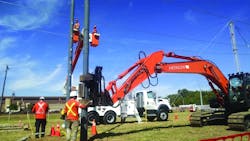Integrating Electric Utility Field Perspectives
Incorporating field employees’ perspectives into strategic and day-to-day decision making is crucial for a successful organization. These craft workers provide unique and diverse perspectives that cannot be found elsewhere in the organization, and they are the best equipped to respond to changes in their work environment. Nearly one in four employees at Western Area Power Administration work in the field, including linemen, electricians, electronic equipment craftsmen, converter technicians, heavy equipment operators, protection and communication craftsman, and meter and relay specialists.
Omitting 25% of an organization’s workforce from decision making would be unthinkable in many industries, but is a regrettably common practice in the utility industry, including at WAPA when I first arrived six years ago.
Integrate Field Perspectives at the Top
One of the first things I did at WAPA was to start a strategic roadmapping process. During an initial meeting with senior leadership, I advocated for involving the field employees in the development of the new strategic plan.
One of the senior vice presidents argued that the field employees were not interested and did not need to be involved with strategic planning. He said the field workers were like people who mowed lawns. They did not care what was happening around them; their job was to mow the grass. I then asked what would happen if someone paved the grass. The SVP had no response.
About a year later, we finalized Strategic Roadmap 2024 as our new strategic plan, identifying our goals over the next 10 years so we could continue to deliver on our mission in a new energy frontier. We also developed a Tactical Action Plan, which is a list of priorities and activities updated every two to three years to guide our way to the goals in the Roadmap.
When we shared the plan with our field personnel, they struggled to see where they fit at first. Over time, they began to make connections with multiple areas that help drive our strategic direction and keep the lights on for more than 40 million Americans.
Customize Tools and Processes by Them, for Them
Nowhere is their involvement more apparent than asset management, one of our focus areas under the Tactical Action Plan. With about US$4.3 billion in transmission assets, we need to make the right investments to maintain a sustainable and affordable grid in the future.
Good asset management hinges on field participation. The craft employees’ tremendous field knowledge of assets, combined with standardized data collection and analysis, provides comprehensive and clear recommendations on how to invest in our transmission system.
Collecting this field knowledge was a new endeavor for us. We had to purchase a new tool to collect and submit asset health and condition information and also convince field employees to use it. Although it was important for the tool to be simple, hardy and improve existing work practices with minimal disruption, we also needed the field employees to feel a sense of ownership in the tool and the process. The craft employees were responsible for working directly with the vendor to customize it to their specific needs.
The tool and the process were made for them, by them, and as a result, the field employees’ adoption has outpaced our office staff. They are asking for additional functionality faster than we can build it.
Empower Innovation
WAPA prides itself on being an innovative and continuously improving organization. Employees are encouraged to find areas of improvement in their spheres of influence and seize the initiative to make it better.
Despite what many think, the craft employees are not impervious nor resistant to change. New technologies and regulations are emerging with increasing regularity. It is important not to constrain employees to their work in the field, but allow them to explore new technologies and how other utilities are conducting their business. When you allow employees in the field to take the lead in improving their work practices, you will see something great. Solutions to their work challenges must come from the field. They cannot come from a mandate. I will not be solving these issues in my office. Only they can solve them.
Be Present
Finally, and most critically, be present for the craft employees. Make sure you are there and that they know you are there. See firsthand what they do, the challenges and opportunities they face and work with them to resolve those issues. Listen to them in their environment, not in the comfort of your office. This is not a one-and-done activity. This is a relationship that requires cultivation.
Craft employees as a whole take great pride in what they do and they should be proud. The work they do powers the American economy and society. They are a motivated group ready to take part in doing their job better. Harnessing that energy can help drive an organization forward in the energy frontier.
Unlock your employees’ potential for the benefit of your entire organization, then stand back and reap the rewards of an empowered and engaged workforce.
